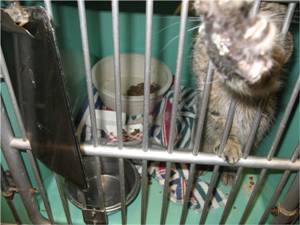As scandals involving abusive animal control officers and shelter workers erupt nationwide, HSUS calls for “National Animal Shelter Appreciation Week.”

Dedicated to abuse and neglect? HSUS demands that we appreciate the “dedicated” staff of shelters who cause this, and then turn around and fight efforts when animals lovers call for reform. At this shelter, state inspectors found: “severe fly and maggot infestation,” “overwhelming maladorous smell,” “large amount of blood was found splattered on the floor, walls, and viewing window,” sick and injured animals “not being treated.”
Last week was “National Animal Shelter Appreciation Week,” the Humane Society of the United States’ celebration of animal shelters and the “dedicated people” who work at them. According to the press release, HSUS is “the strongest advocate” for shelters.
At the same time as HSUS was proclaiming itself the Number 1 cheerleader for shelters in the country, there has been a significant amount of nationwide media coverage revealing widespread animal neglect and outright abuse at these very institutions. These exposes show a strikingly different reality than the fantastical and mythical description of shelters portrayed by the very agency that is supposed to be their watchdog. These stories include:
In Memphis, TN, shelter workers not only intentionally starve animals to death; they take animals who are still alive to the incinerator where they burn the bodies of the animals they kill.

Puppy when he entered the Memphis shelter.

Same puppy after being intentionally staved by shelter workers, before he died.
In King County, WA, an animal control officer turns whistleblower and not only confirms the neglect and abuse uncovered in three independent assessments (click here and here and here), but that things are worse than ever for the animals, despite the denials of the guild/union that blindly defends itself and its members. The whistleblower describes “cats dying in their cage for lack of treatment, a dog so sick [he] nearly drowns in a stream of water in its kennel and animals of all types in need of veterinary attention, but not getting it.”

A sick cat in the infirmary goes without food, water, or litter during a holiday weekend. Take a photo tour of King County Animal Care & Control by clicking here.
In Lucas County, OH, the dog warden—an incompetent hack given the job out of nepotism—routinely allows dogs to get sick and then slaughters them despite readily available lifesaving alternatives.
In Los Angeles County, a news investigation team uncovered officers physically abusing animals. In Tulare County, CA, officers were convicted of criminal offenses. The list goes on and on and on and on.
These stories describe shelter workers and Animal Control Officers who kick, beat, baton, and kill puppies.

Blood splattered on kennel in this San Bernardino County shelter after an animal control officer beat a puppy with a baton. He was not fired.
Those who cause animals to suffer and die.
Those who cause animals to cannabalize other animals in their cages because they go unfed.
And the very animal control officers who cause this suffer no repercussions because they are “supervised” by their fellow union and bureaucracy-protected shirkers.
The Status Quo
All of these scandals beg the obvious question raised by HSUS’ “National Animal Shelter Appreciation Week”: What is it about animals shelters that we are supposed to appreciate? As I argued in Redemption, underperformance, neglect, uncaring and even cruelty have long been epidemic and endemic to animal control shelters. And while the last several weeks have seen much abuse uncovered, it isn’t necessarily because such abuse is on the rise. More of it is making headlines these days because more people are now aware of the neglect, calling attention to it, and demanding change—even in the face of absolute entrenchment by the animal sheltering industry and their allies in the large national “animal protection” organizations. Organizations which continue to ignore the obvious and parrot tired and disproven clichés that these shelters are doing the best they can, the killing is inevitable, no one wants to kill, and that we should regard the animal control officers and other shelter staff with respect and gratitude.
HSUS’ latest public relations gimmick is part of a larger attempt by the very animal control officers responsible for this neglect and abuse to reform their image from one of “dog catcher” to “humane law enforcement.” They are trying to change the image of their agencies from “pounds” to “shelters,” from “animal control” to “animal care and control,” even while they refuse to reform their regressive and abusive practices which—were they to end—would naturally lead to the respect and gratitude they claim to be seeking.
True Accountability
The issue was brought into stark relief for me at a recent city council meeting I attended on a matter related to the local shelter. Before the issue I was there to discuss came up on the agenda, the fire chief spoke to the city council. He talked about the goals for his agency during the coming fiscal year. He spoke of his agency’s response times compared to the best performing departments in the country. He admitted that his Fire District lagged behind the very best. He spoke of how he was going to close the gap, by implementing a series of short, medium, and long term goals with measurable results. He was aspiring for his department to be the best, he admitted they fell short, and he had a plan to correct that. It was the mark of the true professional.
In sheltering, we have the exact opposite: animal control “professionals” denying reality, shunning accountability, aspiring to mediocrity and failure, all while betraying the animals (and the citizens) they are pledged to serve.
In Austin, Texas, for example, the director of the shelter defrays criticism for her appalling kill rates by telling the City Council that she is doing better than the worst shelters in Texas, by comparing herself to agencies where employees are convicted child molesters, have been witnessed abusing puppies, where kittens do not get fed, and puppies get flushed down trench drains. By that standard, everyone is doing a good job. But why does the animal control chief of a major city aspire to compare herself to the worst of the worst?
In the Minneapolis, Minnesota area, the director of the large humane society which performs animal control for the region defends her 42 percent killing rate for dogs by saying it is better than the national average. It is, in fact, actually worse than the national average, but the question is the same: why do she and her agency aspire to mediocrity?
In one of the largest cities in the United States, applicants who apply for a city job are placed in the animal control department if they score the lowest on the city aptitude test, proving that animal control in many communities has become a jobs program for those who are unemployable in either the private sector or any other government agency deemed more important, despite the fact that these under-achievers are given the power over life and death by being put in charge of the most vulnerable of victims. Why?
As I was listening to the fire chief, I was struck by the contrast between how staff in his department approached their responsibilities by being accountable to results, and how shelter staff continues to avoid accountability at all costs, even in the face of rampant neglect and abuse. It is this very attitude that is at the heart of why our nation’s sheltering system is so tragically broken: How can you fix a problem you refuse to admit exists? How can animal control officers reform their practices when they refuse to have standards and benchmarks that would hold them accountable to the best performing shelters in the nation? How can they be expected to be taken seriously, to be respected, when they refuse to acknowledge failures and refuse to correct even the worst of their deficiencies? How can an agency dare to demand respect when they not only refuse to keep pace with the dynamic and innovative changes in their field as a result of the No Kill movement, but actually fight those changes? And how can they do a good job when they are staffed by those who have no skills, training, or desire to do a good job even as they are entrusted to do so by an animal loving public which pays their salaries?
They can’t. Indeed, to be a firefighter often requires a degree in Fire Science, rigorous training, a competitive process, and a sound psychological profile. The same is true of police officers. Even librarians, public servants we rely on to deliver professional, high quality service to the community which funds them, require a bachelor’s degree in Library Science. But “animal control officers” require none of this. Many are not even certified. Others take a one week certificate course from the National Animal Control Association, a regressive organization whose members kill millions of animals every year. Then, they put on a tin badge and a store bought uniform, and give themselves titles like “Sergeant,” in an attempt to demand a legitimacy and stature they do not deserve, nor faithfully represent.
Cheerleaders Instead of Watchdogs
How did this happen? And why do the large national organizations continue to defend these regressive agencies, to be the “strongest advocate” for these agencies, but not the actual animals mistreated and abused by the animal control officers who staff them—even as animal activists in virtually every U.S. community deplore the state of their shelters and find them hostile to change?
As I write in my upcoming book, Irreconcilable Differences, the reason groups like HSUS support the status quo in animal shelters:
Is not based upon any coherent philosophy but arises from the simple fact that some of the leaders of these organizations worked at shelters that killed animals. In fact, many of them killed thousands of animals themselves. HSUS leadership often comes from animal control organizations that kill animals, and these individuals carry that mindset to HSUS, even though it claims a different mission. And so they denigrate the animals they are supposed to protect, and use HSUS to veil their reactionary animal control agendas under the cloak of “animal welfare.”
The result: unregulated, regressive shelters that are defended at all costs by HSUS and others with a series of excuses (pet overpopulation, public irresponsibility) to defray criticism from the public who would otherwise demand better.
They neither work hard to protect animals from abuse, nor do they care about saving their lives. In fact, too many offer only an extension of the abuse these animals faced before entering the shelter. And much more often, the first time animals entering shelters experience abuse and neglect are at the hands of these officers who are supposed to be their protectors.
Standing Up to Bullies
Thankfully, many animal activists and No Kill advocates are well past the point where they believe that just because these agencies come with the name “Humane Society” or “Society for the Prevention of Cruelty to Animals” or “Animal Care & Control” that they are staffed with animal lovers. Activists also realize that given that many of these shelters are committed to remaining little more than assembly lines of death, animal lovers would not work there, and those that do are quickly driven out by the institutional inertia and uncaring that prevents them from reforming practices and saving more lives. They are also driven out under threats:
In Philadelphia, just a few short years ago, reformist-minded staff had the tires on their cars slashed, sugar poured in gas tanks, windows smashed, and were threatened with physical violence by union thugs who were aided by health department bureaucrats intent on protecting shirkers.
In Indianapolis, the reformist director had the window smashed and dog food smeared on his car before union thugs colluded with politicians and others to drive him out.

A reformist director is greeted by shelter thugs with smeared dog food, then a smashed windshield, and fimally threatening letters on his car.
In King County, WA, those who come forward to reform the abusive shelter are the subject of character assassination, aided by a corrupt county executive. The whistleblower—whose conscience apparently got the better of him/her—sought “whistleblower protection” because of fear for his/her job and safety.
In a rural Georgia pound, cats were found dead (a necropsy determined they had been poisoned by antifreeze and only staff had access to these animals), which outspoken volunteers who had convinced the county to investigate conditions at the shelter believe was retaliation for their going public.
While the recent exposes are less and less surprising to animal activists and No Kill advocates, they are helping to inform the larger animal-loving American public of this widespread abuse and neglect, which cuts through the fog of misinformation peddled by guilds/unions, bureaucrats, and the large national organizations that shelters are humane and that their staff are caring. As I write in Irreconcilable Differences:
Most people believe that animal shelters find homes for as many animals as they can, and gently “euthanize” the rest because there is no other choice. Many people believe that if there were alternatives, shelters would not kill because they are staffed with benevolent animal lovers, laboring against overwhelming odds and offering a humane death only when necessary. Because we could not do it, we assume they do it because they have no choice.
These shelters and their large national allies—the Humane Society of the United States, the ASPCA, and the National Animal Control Association—encourage this belief. Accordingly, they claim that leadership and staff at every one of these agencies “have a passion for and are dedicated to the mutual goal of saving animals’ lives.”
It is this portrayal that silences criticism of shelters, the vast majority of which have a paltry number of adoptions and staggeringly high rates of killing. The public is told, “We are all on the same side,” “We all want the same thing,” “We are all animal lovers,” and criticism of shelters and staff is unfair and callous because “No one wants to kill.”
The facts, of course, tell a tragically different story. But there is light at the end of this long, dark tunnel. HSUS knows it. NACA knows it. The guilds and unions know it. Even the abusive staff knows it. We—animal activists, and increasingly, the media and your average animal loving American—are on to them. We see through their tin badges, store brought uniforms, and their made-up titles. And together—whether they like it or not—we will bring these agencies kicking and screaming into the 21st Century.
Then—and only then—will we have something authentic to appreciate during what is now, nothing more than a thinly-veiled sham.
What You Can Do:
Get informed: Click here.
Get organized (Samples): Click here and here and here.
Fight back: Click here.